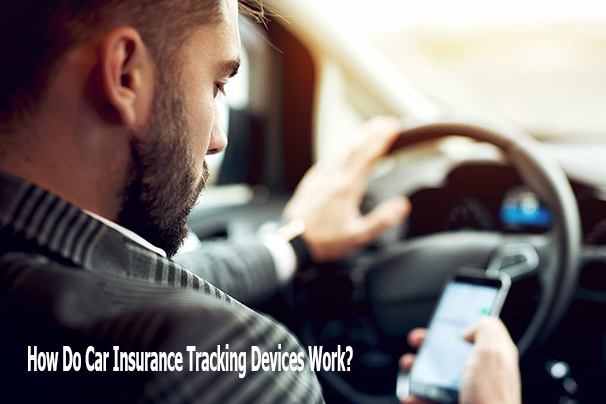Car insurance tracking devices are used by insurance companies to monitor your driving habits and set the correct rates based on your level of risk. These devices can either be installed in your car or accessed through a smartphone app.

These days, usage-based car insurance programs that use tracking devices are becoming popular as they offer lower rates for drivers who drive safely or infrequently. However, before choosing such a program, it’s essential to understand how these devices work, what data they gather, and how they impact your insurance rates.
What is a Car Insurance Tracker?
Meanwhile, a car insurance tracker is a smartphone app or plug-in device that tracks your vehicle, driving habits, and a lot more. It can provide savings of up to about 30% off your insurance rates. One of the first that comes to mind is the Progressive Snapshot, which may offer usage-based premiums.
Types of Auto Insurance Trackers
There are two main types of auto insurance trackers available, which are as follows:
- Physical telematics device or dongle: This is the one that you can plug into your vehicle.
- Smartphone app: This is the one that you can download.
The choice of device typically depends on your insurance provider or the program you opt for.
How Does it Work?
Meanwhile, Auto-tracking devices used by insurance companies work differently depending on the equipment used. If the insurer makes use of a stand-alone device, it is worked into the OBD-II port, which is regularly located beneath the steering wheel. This device makes use of your car’s onboard diagnostic system and a network of sensors to track performance indicators, including fuel and oil levels, mileage, and tire pressure. The device collects information about your driving patterns, such as speed, braking, and distance traveled.
If the insurer makes use of a mobile tracking device, you can download the app and follow the instructions. The app makes use of the sensors on your smartphone to gather data on your driving, such as sudden acceleration and hard braking.
Regardless of the method used, the data collected is sent to the insurer, where it is encoded and used to assess your driving habits and determine your rate and any discounts or program benefits for which you qualify.
What Data is Tracked?
Most insurance companies are clear about the data they collect, which can be accessed on their website or by speaking with an agent. The objective is to gather information about your typical driving habits, with a concentration on behaviors that may raise the risk of accidents or contribute to safer driving. Commonly collected data are as follows:
- instances of hard braking.
- Also, driving speed.
- The time of day, with particular courtesy to nighttime driving.
- Also, frequency and period of your driving.
- Episodes of hard rushing.
- Sharp and debauched cornering, revealing quick turns.
- Phone usage while driving is an indicator of distracted driving.
Upon getting this data, insurance companies use mapping data to evaluate the traffic controls in place along your driving routes, like stop signs and speed limits. This analysis helps them assess if you follow safe driving practices or frequently engage in hazardous behaviors like speeding or disregarding traffic rules.
Do I need an Insurance Tracker?
Making use of telematics systems or trackers is usually optional for drivers, but there are conditions where they can be a wise choice, especially if you wish to take advantage of particular programs provided by your insurance company. These programs include usage-based insurance (UBI) programs and pay-per-mile insurance.
Usage-based Insurance (UBI) Programs:
UBI programs regulate your insurance rates based on your driving habits. Also,if you are a reliably safe driver, meaning you dodge speeding, abrupt braking, and disruptions, UBI programs can lead to reduced insurance rates. These programs can also benefit drivers who don’t frequently use their vehicles.
Pay-Per-Mile Insurance:
Meanwhile, ay-per-mile insurance involves tracking the number of miles you drive over a set period, typically around four weeks. In this arrangement, you pay a base insurance rate along with an extra rate per mile. Also, this regularly comes with the outcome of lower monthly premiums associated with traditional coverage. Pay-per-mile plans are particularly beneficial for those who work from home, have short commutes, or rarely drive, as they avoid overpayment for insurance.
A lot of major insurers, including Geico, USAA, and State Farm, provide usage-based insurance programs. However, fewer offer true pay-per-mile or pay-as-you-go plans that completely base your rate on mileage.
Where can I get insurance trackers?
Meanwhile, a lot of national insurance companies offer tracking-based insurance, primarily through usage-based insurance (UBI) programs that provide enticements for safe driving. They are as follows:
- American Family: Know Your Drive.
- Geico: DriveEasy.
- Progressive: Snapshot.
- Travelers: IntelliDrive.
- Allstate: Drivewise.
- Farmers: Signal.
- Nationwide: SmartRide.
- State Farm: Drive Safe and Save.
- USAA: SafePilot.
The data collected and its influence on your rates can vary between the companies listed above, so it’s essential to ask about their exact data collection methods and rate adjustments.
Conclusion
Finally, car insurance tracking devices are becoming more popular as they give drivers and insurance companies valuable data about driving habits. This data is collected through telematics systems or trackers, which can be installed as physical devices or accessed through smartphone apps. The information collected includes factors like speed, braking patterns, and the time of day you drive.
